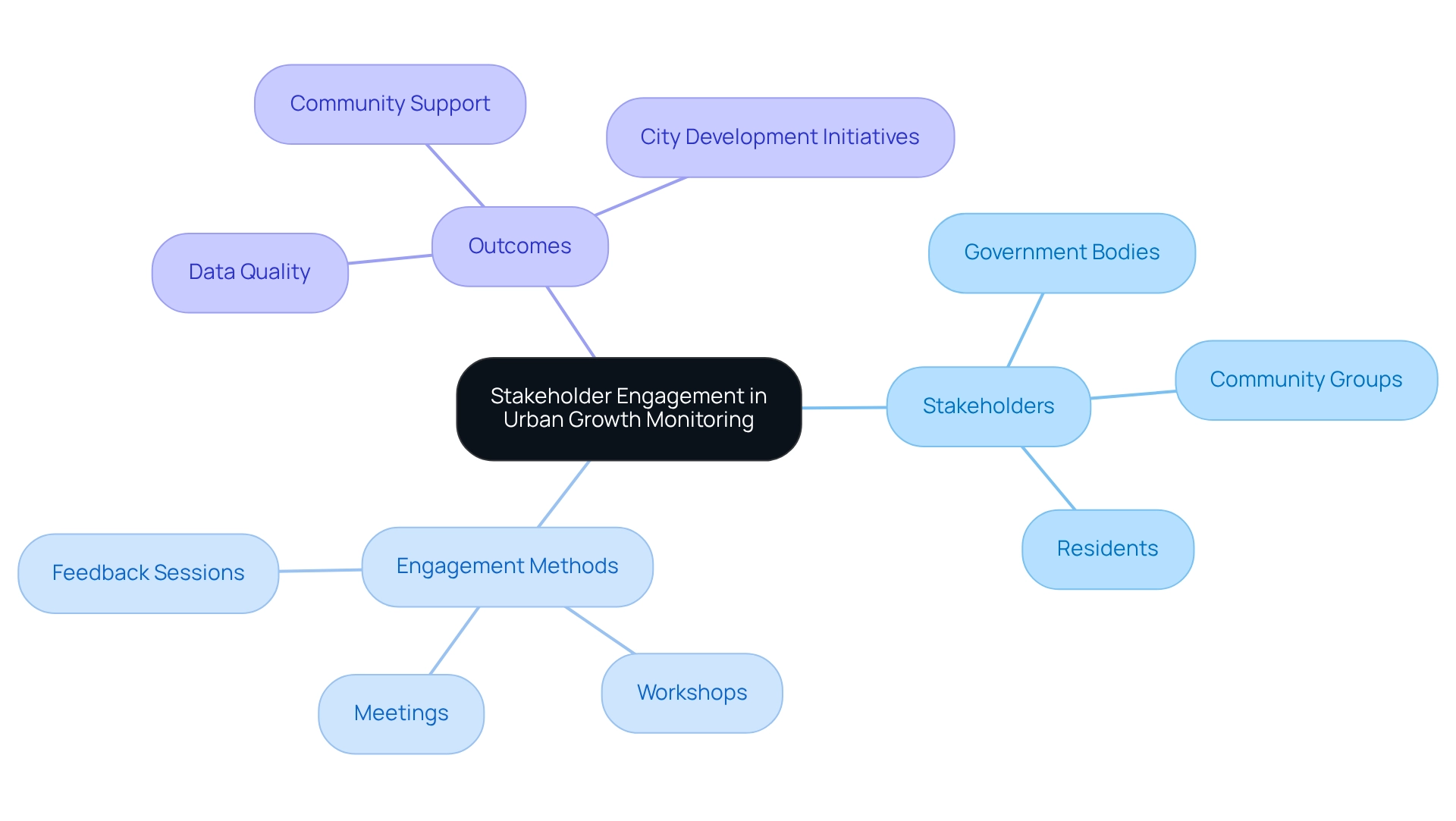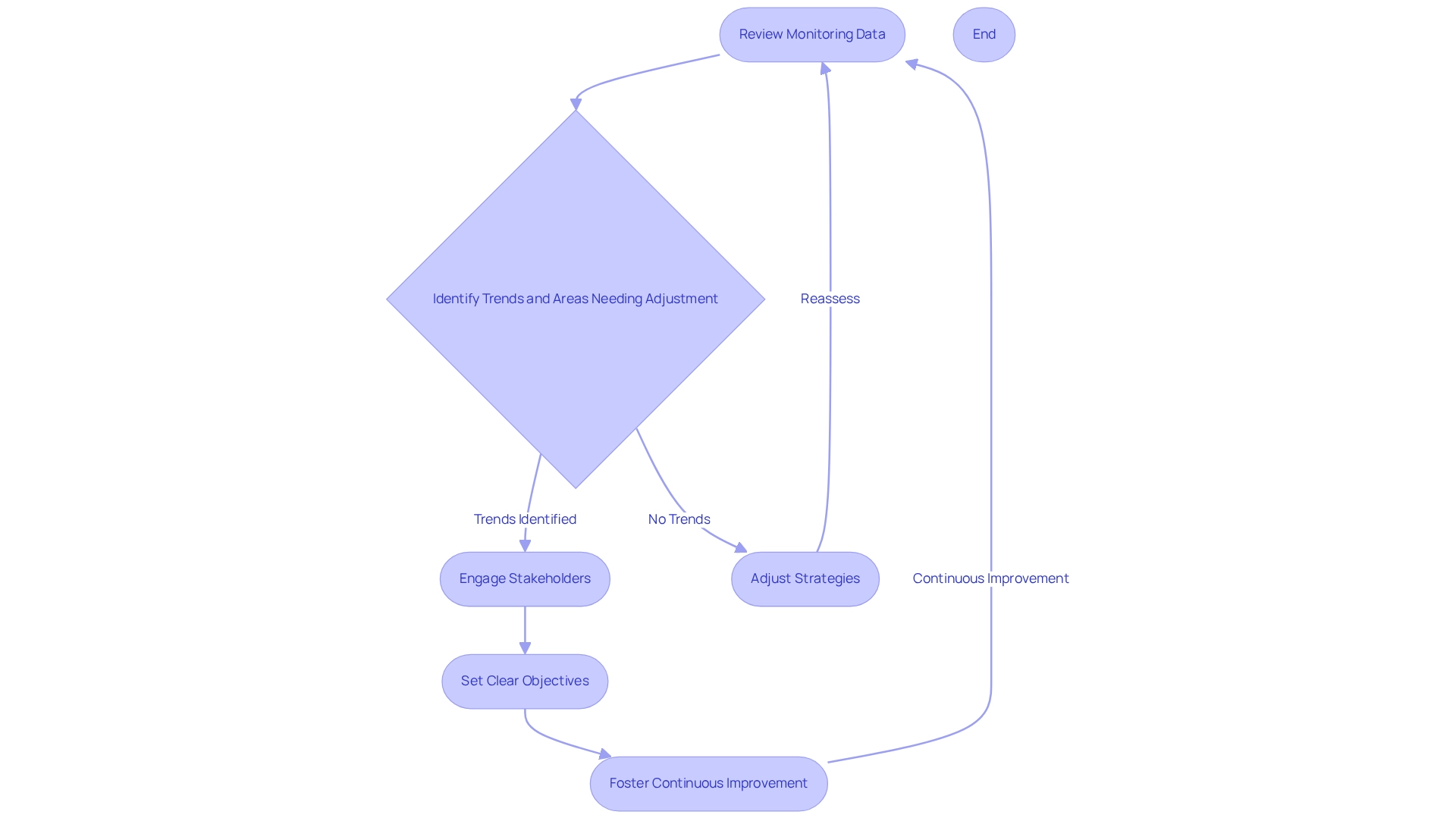Overview
The article presents four essential strategies for effective large-scale urban growth monitoring. These strategies emphasize the significance of:
- Defining SMART objectives
- Leveraging advanced technologies
- Engaging stakeholders
- Establishing a framework for continuous evaluation and adaptation
Evidence underscores the necessity of data-driven approaches, highlighting community involvement and the need for ongoing adjustments to facilitate successful urban planning and development. By embracing these strategies, urban planners can navigate the complexities of growth and ensure sustainable outcomes.
Introduction
In the face of rapid urbanization, cities confront a pressing challenge: the effective monitoring of their growth to secure sustainable development and enhance quality of life. This article explores the essential components of urban growth monitoring, underscoring the necessity for well-defined objectives, the integration of advanced technologies, and the active involvement of stakeholders.
By establishing SMART goals tailored to the distinct characteristics of urban areas, cities can leverage cutting-edge data collection tools and foster collaborative efforts among community members to adapt to evolving challenges. Moreover, the significance of continuous evaluation and adaptation strategies cannot be overstated; these enable urban planners to remain responsive to the dynamic nature of urban environments.
As cities strive for resilience and efficiency, grasping these foundational elements of urban growth monitoring becomes crucial for shaping the future of urban living.
Define Objectives for Urban Growth Monitoring
Effective monitoring of large-scale urban growth hinges on the establishment of specific, measurable, achievable, relevant, and time-bound (SMART) objectives tailored to the unique characteristics of the area. These objectives must tackle critical factors such as:
- Population growth management
- Land use optimization
- Infrastructure enhancement
For example, a city may set a target to reduce suburban sprawl by 20% within five years. By clearly defining these objectives, stakeholders can synchronize assessment efforts with the city’s strategic vision, facilitating timely adjustments in response to changing conditions.
Regularly revisiting and refining these objectives based on data insights not only fortifies the monitoring process but also boosts the overall success of city development initiatives. Notably, 88% of municipalities regard digital twins as vital for future climate resilience, enabling them to simulate worst-case scenarios and plan accordingly. This underscores the importance of data-driven approaches in large-scale urban growth monitoring for establishing and achieving city development goals.
Furthermore, city development specialists emphasize that quantifiable objectives are crucial for fostering sustainable growth and ensuring metropolitan regions can adapt to future challenges. As Henry David Thoreau aptly stated, "If you have built castles in the air, your work need not be lost; that is where they should be. Now put the foundations under them." This quote highlights the necessity of creating a solid foundation for city development goals.
Additionally, the increasing adoption of local disaster risk reduction strategies by a significant proportion of local governments reflects a growing acknowledgment of the need for structured planning. Ultimately, large-scale urban growth monitoring aims to achieve balanced territorial development and enhanced local fiscal space, further reinforcing its essential role in improving quality of life and attracting talent and enterprises to metropolitan areas.
Utilize Advanced Technologies for Data Collection
Integrating advanced technologies into large-scale urban growth monitoring significantly enhances the processes of data collection. Tools such as satellite imagery, drones, and Geographic Information Systems (GIS) enable thorough mapping and analysis of urban regions. Consider the role of remote sensing methods, which have been essential in large-scale urban growth monitoring and in revealing critical insights into land use changes and city expansion trends over the past twenty years. A notable example is the incorporation of Earth Observation datasets into World Bank activities, illustrating the increasing reliance on satellite technology for data-driven decisions in urban development and disaster risk management.
Furthermore, AI algorithms can analyze extensive datasets to identify trends and predict future development scenarios, empowering city planners to make informed choices. The application of satellite imagery has surged, with research underscoring its pivotal role in large-scale urban growth monitoring and development strategies. For instance, the evolution of Nigerian cities from 2000 to 2020 highlights significant metropolitan expansion patterns that can be examined using large-scale urban growth monitoring technologies. Moreover, manual classification conducted by sampling observations for land use categories from Landsat 7 images in 2020 exemplifies the practical application of satellite imagery in urban planning.
As Vivien Deparday aptly states, "Looking beyond human expansion," it is crucial to consider the broader implications of urban development assessment. By leveraging these advanced technologies, city planners can access more accurate and timely data, ultimately leading to more effective management strategies and improved outcomes for communities.
Engage Stakeholders for Collaborative Monitoring Efforts
Effective oversight of large-scale urban growth monitoring hinges on the active engagement of diverse stakeholders, including government bodies, community groups, and residents. This cooperative atmosphere enables planners to tailor evaluation efforts to meet the community's varied needs. Regular stakeholder meetings, workshops, and feedback sessions promote open communication, allowing local knowledge and perspectives to shape monitoring strategies. Involving community members in data gathering not only enhances the accuracy of information but also fosters a sense of ownership over city development initiatives. This collaborative approach has been shown to significantly improve data quality and bolster community support for large-scale urban growth monitoring in city planning efforts.
A systematic review of 38 case studies identified 12 distinct purposes for community engagement, highlighting the essential role of stakeholder involvement in achieving successful city development outcomes. Furthermore, the onion model provides a structured approach for selecting appropriate participatory techniques based on the development stage, engagement level, and objectives of community involvement.
As emphasized by Kaushal Keraminiyage in "Mapping Participatory Methods in the Urban Development Process: A Systematic Review and Case-Based Evidence Analysis," aligning engagement strategies with community needs is paramount. Additionally, the analysis of 18 comprehensive city development scenarios reinforces the effectiveness of stakeholder involvement. As city designers look toward 2025 and beyond, prioritizing stakeholder engagement will be vital for effective planning and large-scale urban growth monitoring in metropolitan development assessment.

Implement Continuous Evaluation and Adaptation Strategies
To ensure the effectiveness of city development assessment, large-scale urban growth monitoring must involve continuous evaluation and adaptation strategies. This process of large-scale urban growth monitoring involves regularly reviewing tracking data to assess the effectiveness of current strategies and making necessary adjustments based on findings. For instance, if data indicates that city expansion is exceeding forecasts, planners may need to revise their goals or enhance their methods for large-scale urban growth monitoring. Establishing feedback loops that incorporate stakeholder input is crucial for large-scale urban growth monitoring, ensuring that the monitoring efforts align with community needs and priorities. As Bosch et al. noted, "A smart city is a city that mobilises and utilizes available resources to enhance its residents’ quality of life," underscoring the significance of community participation in city development. A study on city density highlighted that maintaining optimal density levels is vital for enhancing livability and sustainability in metropolitan environments, further emphasizing the necessity for large-scale urban growth monitoring and continuous evaluation and adaptation strategies. Scores above 700 points indicate excellent quality in city planning efforts, providing a quantitative measure of success.
To implement continuous evaluation and adaptation strategies effectively, urban planners should consider the following steps:
- Regularly review monitoring data to identify trends and areas needing adjustment.
- Engage stakeholders to gather input and ensure alignment with community priorities.
- Set clear objectives that can be revised based on data findings.
- Foster a culture of continuous improvement within planning teams.
However, common pitfalls should be avoided, such as neglecting stakeholder feedback or failing to adjust strategies in response to new data. By fostering a culture of continuous improvement, urban planners can significantly enhance the resilience and sustainability of large-scale urban growth monitoring efforts, ultimately leading to the development of smarter, more adaptive cities.

Conclusion
Establishing effective urban growth monitoring is essential for cities pursuing sustainable development and improved quality of life. By defining SMART objectives that align with the distinct characteristics of urban areas, cities can effectively manage population growth, optimize land use, and enhance infrastructure. The integration of advanced technologies, including satellite imagery and AI, significantly improves data collection, equipping urban planners with the insights necessary for informed decision-making. Moreover, involving stakeholders in the monitoring process encourages collaboration, ensuring that the diverse needs of the community are adequately addressed.
The necessity of continuous evaluation and adaptation cannot be overstated. Regularly reviewing monitoring data empowers urban planners to adjust strategies in response to evolving conditions, thereby ensuring that urban growth remains in harmony with community priorities. By fostering a culture of continuous improvement, cities can bolster their resilience and sustainability, ultimately leading to more effective urban management.
In summary, the foundational elements of urban growth monitoring—establishing clear objectives, leveraging advanced technologies, engaging stakeholders, and implementing ongoing evaluation—are pivotal for shaping the future of urban living. As cities confront the challenges of rapid urbanization, adopting these practices will not only enhance quality of life but also cultivate environments that are adaptable and resilient to future changes. The journey towards sustainable urban development hinges on a steadfast commitment to these principles, ensuring that cities can flourish amidst ever-evolving challenges.
Frequently Asked Questions
What are SMART objectives in the context of urban growth monitoring?
SMART objectives are specific, measurable, achievable, relevant, and time-bound goals tailored to the unique characteristics of an area, crucial for effective monitoring of large-scale urban growth.
What critical factors should urban growth objectives address?
Urban growth objectives should address population growth management, land use optimization, and infrastructure enhancement.
Can you provide an example of a SMART objective for urban growth?
An example of a SMART objective is a city setting a target to reduce suburban sprawl by 20% within five years.
How do clearly defined objectives benefit city stakeholders?
Clearly defined objectives allow stakeholders to synchronize assessment efforts with the city’s strategic vision, facilitating timely adjustments in response to changing conditions.
Why is it important to regularly revisit and refine urban growth objectives?
Regularly revisiting and refining objectives based on data insights strengthens the monitoring process and enhances the overall success of city development initiatives.
What role do digital twins play in urban growth monitoring?
Digital twins are regarded as vital by 88% of municipalities for future climate resilience, allowing them to simulate worst-case scenarios and plan accordingly.
Why are quantifiable objectives important for city development?
Quantifiable objectives are crucial for fostering sustainable growth and ensuring metropolitan regions can adapt to future challenges.
What does the quote by Henry David Thoreau imply about city development goals?
The quote emphasizes the necessity of creating a solid foundation for city development goals, suggesting that lofty ambitions must be grounded in practical planning.
How are local disaster risk reduction strategies related to urban growth monitoring?
The increasing adoption of local disaster risk reduction strategies by local governments indicates a growing acknowledgment of the need for structured planning in urban growth monitoring.
What is the ultimate aim of large-scale urban growth monitoring?
The ultimate aim of large-scale urban growth monitoring is to achieve balanced territorial development and enhanced local fiscal space, which improves quality of life and attracts talent and enterprises to metropolitan areas.
List of Sources
- Define Objectives for Urban Growth Monitoring
- Goal 11 | Department of Economic and Social Affairs (https://sdgs.un.org/goals/goal11)
- Digital Twin Adoption in Smart Cities: Growth & Application Stats (https://patentpc.com/blog/digital-twin-adoption-in-smart-cities-growth-application-stats)
- Smart Cities and Urban Development Market Size & Industry Growth 2030 (https://futuredatastats.com/smart-cities-and-urban-development-market?srsltid=AfmBOoqBW8jLnxyKEOEer9Aq1on-9BPueHrrfOHy1BPoybDjAJuFmMlS)
- Quotes, Urban Planning, Inspiring | Urban Innovators (https://urbaninnovators.com/inspiring-urban-planning-quotes)
- Utilize Advanced Technologies for Data Collection
- Insights from Space: Monitoring City Expansion with AI-Powered Satellite Technology (https://blogs.worldbank.org/en/sustainablecities/insights-from-space--monitoring-city-expansion-with-ai-powered-s)
- Tracking Urban Expansion Through Satellite Imagery | D-Lab (https://dlab.berkeley.edu/news/tracking-urban-expansion-through-satellite-imagery)
- Engage Stakeholders for Collaborative Monitoring Efforts
- Mapping Participatory Methods in the Urban Development Process: A Systematic Review and Case-Based Evidence Analysis (https://mdpi.com/2071-1050/13/16/8992)
- Implement Continuous Evaluation and Adaptation Strategies
- Evaluating Urban Quality: Indicators and Assessment Tools for Smart Sustainable Cities (https://mdpi.com/2071-1050/10/3/575)




